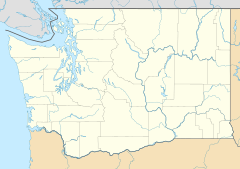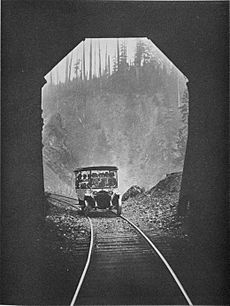Monte Cristo, Washington facts for kids
Quick facts for kids
Monte Cristo
|
|
|---|---|

Townsite in 2014
|
|
| Country | United States |
| State | Washington |
| County | Snohomish |
| Elevation | 2,762 ft (842 m) |
Monte Cristo is a fascinating ghost town located in western Washington. It's found in the eastern part of Snohomish County, near Monte Cristo Peak. This town was once a busy place where people mined for gold and silver between 1889 and 1907. After the mining stopped, it became a popular vacation spot until 1983.
Contents
Where is Monte Cristo?
Monte Cristo sits at the very beginning of the South Fork Sauk River in eastern Snohomish County. You can reach the town by following a trail from the Mountain Loop Highway. This highway goes west towards Granite Falls and north to Darrington. The tall Monte Cristo Peak is named after the town and can be found to the southeast.
The Story of Monte Cristo
Early Discoveries and Trails
People started looking for valuable minerals in this area around 1882. An early trail, the Old Cady Trail, helped them get around. Later, Elisha Hubbard improved a trail from Index to Galena. This led to a small mining boom at Mineral City.
Miners then followed the mineral deposits in different directions. In 1889, Joseph Pearsall found glittering rocks near what became Monte Cristo. This discovery caused a rush, and many people quickly claimed land.
Building Access to the Town
In 1890, many miners hiked to Monte Cristo from the south. They crossed mountains using passes like Wilmans Pass and Poodle Dog Pass. By 1891, a narrow wagon road, the Wilmans or Pioneer Trail, was finished. This road connected Monte Cristo to Sauk City on the Skagit River, allowing access from the north.
Another route was found in 1891 from Silverton. Surveyors like M.Q. Barlow mapped a path. Important mining investors, including Judge Edward Blewett and Hiram G. Bond, helped fund more work. Soon, a wagon road was built over Barlow Pass. This road later became a railway.
The Mining Boom Years
Monte Cristo was the first active mining camp on the west side of the Cascade Range. By 1891, there were 13 mines and 40 claims. This number grew to 211 mining claims by 1893. To keep growing, the mines needed money from wealthy investors.
In 1891, John D. Rockefeller, a very rich businessman, became interested. His companies bought the main mines, including the Pride and Mystery mines. They paid the Wilmans brothers $470,000. Rockefeller's groups ended up owning most of the best mining properties. Frederick Trump, the grandfather of a future U.S. President, also ran a hotel in the busy town.
Hopes were very high in Monte Cristo during the 1890s. Many believed it would become the biggest lead-silver mining area in the Western Hemisphere. They built amazing cable-bucket systems to carry ore from the mines to the town. These systems could move up to 230 tons of ore every day.
A large building called a concentrator was finished in 1894. It helped process the ore. The processed ore was then shipped out on a new 42-mile-long railway. The town's population peaked in 1894, with over 1,000 people living there. By 1895, 125 men worked in the mines. Their monthly pay was $10,500. This number grew to 200 workers in 1896. Mining activities supported about 600 people in total.
Challenges and Decline
The year 1896 was good, but in November, huge floods damaged the railroad tracks and tunnels. Mining output reached its highest level in 1897. However, more intense floods in the autumn destroyed the area's transportation. Fixing these problems cost a lot of money, which hurt mining profits.
Other issues, like unwanted metals in the ore, also caused problems. By 1900, most of the Monte Cristo miners had left. They went to new mining booms, like the Klondike gold rush.
Miners and geologists had made mistakes about how much mineral wealth Monte Cristo truly had. There were rich deposits near the surface, but they didn't go deep into the ground. Mining below about 500 feet usually wasn't worth the effort. Mining operations finally stopped in 1907, likely due to a financial crisis called the Panic of 1907.
Monte Cristo Today
The town survived as a tourist spot for several more decades. However, a county road was flooded in December 1980. The last business in town, a lodge, burned down in 1983. That same year, a group called the Monte Cristo Preservation Association started working to save and restore the historic site.
Very few of the original buildings are still standing. The four-mile-long road into town is still popular with hikers and mountain bikers. However, vehicles cannot use the road anymore. A bridge's supports washed out years ago. Hikers and bikers now have to cross the river or use fallen trees to reach the old town site from Barlow Pass.
There are big plans to clean up pollution from old mine waste, called tailings. This includes removing or containing pollution at nearby mine sites. A new access road is also part of these cleanup plans. The cleanup of harmful substances like arsenic began in September 2012.
Some mines that are not completely collapsed include the Boston American Mine, Justice Mine, Mystery Mine, and New Discovery Tunnel.





